Caldwell Family Winery: An Urban Oasis of Texas Wine in Downtown Houston
If you go to Google.com and type in the words “Caldwell” and “Winery”, at the top of the results page you will find links that will launch you into a website for a winery in Napa, California. However, glance just four or five positions down the page and you will find another link to Caldwell winery: Caldwell Family Winery and Vineyards. This winery, however, is located in the downtown landscape of Houston, Texas where it’s evolving into an urban oasis of Texas wine.
As a matter of fact, it’s located only a few miles away from my own metropolitan homestead, and I will have to admit that Caldwell Family Winery slid off my radar despite two prior encounters. I first met Chris Caldwell, proprietor and winemaker at Caldwell Family Winery, in January of this year at the Gulf Coast Grape Field Day in Cat Spring, Texas. Around the same time, when the results of the 2011 Houston Livestock Show and Road Wine Competition results were announced, I read that the 2010 Texas Eaglefire Muscat Blanc (Texas) made by Caldwell Family Winery won a gold medal (in rodeo terms Reserve Class Champion and Texas Class Champion) in the “Other Dry White Category.
I remember at that time saying to myself, “Russ, you really need to stop by that place”. Why, because I noticed that the unfamiliar name of Caldwell Winery in the list of gold medal winners with other more well-known wineries. They included Brennan Vineyards, Llano Estacado Winery, Messina Hof and LightCatcher Winery, of which I was very familiar from tastings, wine competitions and past winery visits. I also remember saying to myself, “Russ, they must be doing something very right over there.”
Then, less than a week ago I was jogged by Jeff Cope who writes the TX Wine Lover blog asking me if I’ve been to Caldwell Winery, and then I received a Facebook invitation for a tasting at the winery that was going to take place this past Friday. I confirmed with him that I would stop by for a visit and a taste.
— — — — —
However, a word of warning is needed at this point. If you are planning to visit the winery and use the Caldwell Family winery’s listed address and punch it into your Garmin, you will likely find yourself about 100 yards too far to the west on West 12th Street in the Heights area of Houston. And, if you drive down the street a bit further to the east looking for a sign saying “Caldwell Winery” or something to that effect, you won’t find it, either. The closest thing that I found was a sign that said, “Vintners Own Winery” and decided to stop there. After dismounting, I walked to an unassuming portal in the back of an old warehouse. There, I found a handwritten wooden sign pointing to the doorway that said “winery”. As I emerged into the cool aromatic cavern of a well-worn warehouse, I came to find out from Chris that Vintners Own is actually the home of Caldwell Family Winery.
— — — — —
Chris, like many new Texas vintners, had to start operations on a small scale and by cutting their winemaking teeth on non-Texas grapes while Texas vineyard contacts and contracts for Texas grapes were developed. In the meantime, his association with Vintners Own provides a source of non-Texas grapes from quality wine growing regions and states.
However, Chris seems to have his goal well set out on his website and made the same pitch in person when he said, “I want to eventually produce premium, all-Texas wines and I’m committed to elevating Texas to the world stage of wine.” Chris is also focused on small lot production (I’d actually call it a micro-winery operation). His goals are consistent with what I affectionately refer to (along with a few local wine aficionados) as “Locapour”. This is actually the less well-known “redheaded stepchild” of the foodie’s “Locavore” movement. While this may be the case presently, Locapour is a concept that is gaining converts pour-by-local-pour.
In a moment, I saw Jeff Cope helping out in the back of the winery and, as is usually the case for wine geeks, we started a discourse on places we’ve been and wines we’ve tasted since our last meet-up at the Texsom Conference in Dallas nearly a month ago.
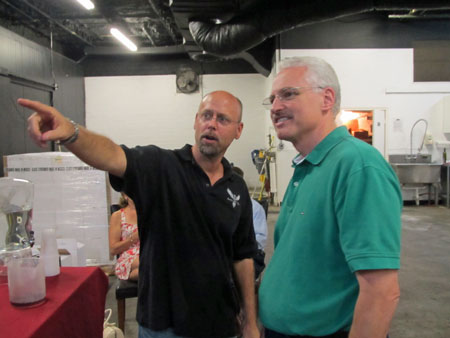
Chris stopped by and started me out on two of his Eaglefire red wines:
- Eaglefire Napa Valley Cabernet Sauvignon with deep extraction of red-purple in color with black fruit, earth and smoke qualities (75% Cabernet Sauvignon and 25% Syrah)
- Eaglefire Napa Valley Reserve Blend that throws a twist to Bordeaux blending that yields a full bodied, fruit dominant wine (50% Cabernet Sauvignon, 40% Merlot and 10% inky Petite Sirah).
Jeff pointed to a large 6-liter bottle of Eaglefire Texas 2010 Mucsat Blanc (the 2011 Houston Rodeo gold medal winner from above) setting out on the table and said “Did you see my bottle of wine”. At first, I didn’t follow his thought, but quickly realized that he’d placed the winning bid for the big bottle of award winning wine. It was proudly displayed along with the Houston Rodeo belt buckle that signified this medal status.
I asked Jeff if the belt buckle came with his actioned bottle of wine, but he acknowledged that it wasn’t part of the deal. He admitted that his remaining dilemma (after figuring out how to store this one very large bottle of white wine) was how to arrange a tasting since his bottle held about 48 to 50 glasses of wine and most of his friends were confirmed red wine drinkers. I committed my support to his cause of consuming this wine, and committed my wife to the cause, as well.
In the absence of popping the top off of Jeff’s 6-Liter bottle of Eaglefire Texas Muscat Blanc, Chris provided us glasses of a golden fluid derived from what I guessed was a much smaller bottle at the tasting room bar. It was his 2010 Eaglefire Blanc Du Bois. The wine was silky-smooth and semi-sweet, produced from Texas grapes that came from the Palacios Vineyard near Brenham, Texas. It was Blanc Du Bois, no doubt with appealing floral, pear and citrus characteristic and a hint of Golden Muscat (which itself is a cross between Muscat Hamburg x Diamond) that’s found in the distant lineage of this French-American hybrid grape.
Chris brought me another glass of red wine that he described as one of his work in progress and awaiting further aging before bottling. It was made from a Cabernet and possibly other red grapes harvested at Reddy Vineyards in the lofty 3,500 foot elevation and red sandy loam of the Texas high plains AVA just south of Lubbock. It was a mighty fine glass of Texas red wine. It proved to me that Chris was serious with his intent to elevate winemaking in Texas, but with an even deeper-driven mission to elevate the making of Texas wines. The interesting aspect this wine was that it had a dark garnet red color, pleasing aroma, and substantial body and flavor. The best way to describe it was as a jammy assembly of red and dark fruits. But, it was different than the Napa Valley Cabernet that I’d just tasted. I’m still trying to put my finger (palate) on what I’m trying to describe. Is being different than Napa bad? Well, I don’t think so. I will try to blog more on this subject in the coming weeks as my thoughts start to jell, and I welcome your comments.
I believe that such aforementioned differences are to be expected since Texas terroir sure as heck is not Napa Valley terroir. It really puts the burden on winemakers, wine writers and wine consumers alike to describe this new Texas wine experience budding around us. When this wine gets released with its brethern, I will leave it up to you to give it a try them for yourself. . Chris admitted that he will be finishing up several Texas red wines between now and their planned release in the fall of 2012. He expects them to include a red blend (60% Cabernet, 20% Cabernet Franc, 20% Petit Sirah), red blend 2 (60% Cabernet, 40% Merlot), and single varietal wines made from Cabernet Sauvignon, Merlot and Malbec.
Just before leaving, Chris found me yet again and asked me to follow him into the barrel room. There he knelt down low and withdrew a glass of his 2011 Eaglefire Texas Muscat Blanc drawn straight from the tank as it was not yet finished nor bottled. I recognized that this wine had all of the interesting characteristics that I find makes Muscat and, for that matter, Muscat-derivatives like Blanc Du Bois leading wine grapes for Texas. This wine was fermented dry with crisp acidity featuring citrus aromas/flavors and the characteristic and lingering fragrance of the Muscat grape. It had all the makings of a mighty fine wine, the only question in Chris’s mind was what style he would use. He talked about bringing in a hint of sweetness back into the wine and perhaps going wild by making it a sparkling wine. If you’ve ever had sparking Blanc Du Bois, it’s mighty fine, yep, mighty fine indeed.

Great to finally see Chris’s place and taste his wines. The ambiance of the old warehouse gave me the feeling like I’d previously experienced at wineries in Woodenville, WA, just outside Seattle. Many were huddled in communes of garagistas occupying distribution center bays with tasting room bars, winemaking facilities, case goods and barrels stacked high, all sharing the same space. I like having our own urban Houston winery and I believe that you will too. Stop by:
Caldwell Family Winery and Vineyards
3482 W. 12th St. Houston, Texas 77008
(Google maps seems to have this location correctly placed, but beware of where your Garmin spots you)
(713) 880-3794
Like most micro-winery operations, hours of operation and events don’t necessarily follow a set schedule. You can keep tabs on Caldwell Family Winery tastings and other winery activities through their newsletter.
— — — — —
Anybody know what this piece of winemaking equipment is? When not in use, it’s a storage table, but that’s not it’s main purpose. It facilitates what can be an important process in making quality wines in Texas and many other wine producing regions around the world? How many Texas wineries do you think have this equipment?

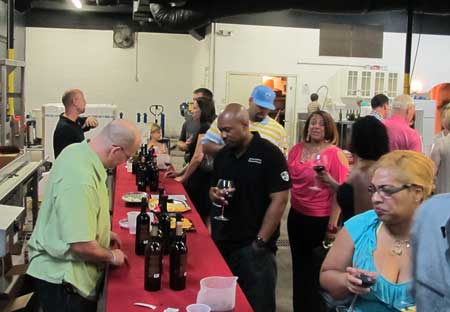
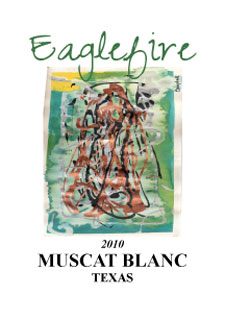
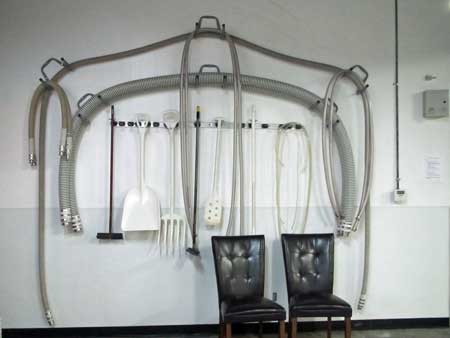
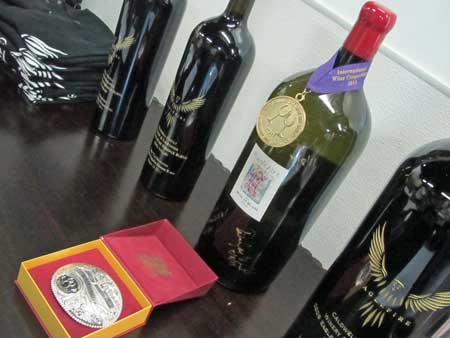
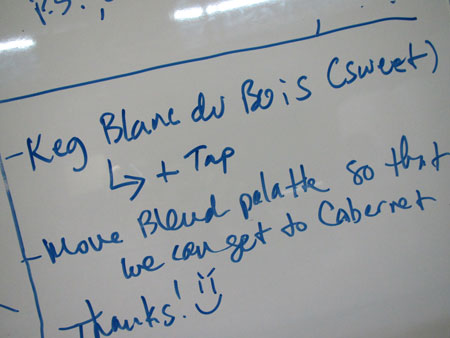
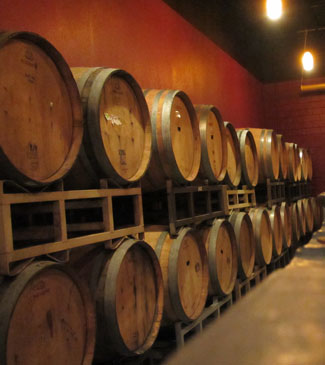


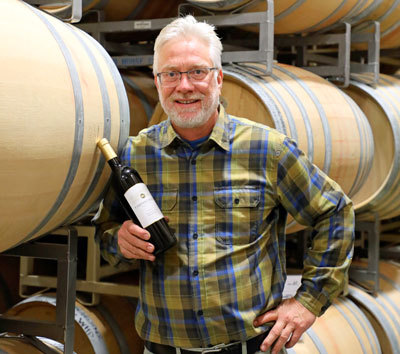
It’s a berry sorter. Did he say he used it this year because it looks brand new? And if he did, how much of decrease in yields did he take?
You are absolutely correct! I don’t know the reduction in yield, but I expect that it varies with the variety of grape and the growing/harvest conditions by year.
I’d heard that in 2009, due to the late spring freeze, a lot of Tempranilo was made on secondary buds which ripened unevenly. Some sorted and some did not leading to variability in the wine produced.
With Texas being more like Europe than California having a variable climate, I think that it is an important piece of equipment for a Texas winery to have.
Thanks for your comment.
Russ
@Jason: 2010 was our first year with the full assembly of vibrating dosage table, sorting table, and elevator. Fruit was cluster sorted, destemmed, berry sorted, then crushed. The slight reduction in yield was worth the quality gained 🙂
@admin: I couldn’t agree more. While expensive – and since growers are reluctant to drop fruit during the season – it is an indispensable piece of equipment.